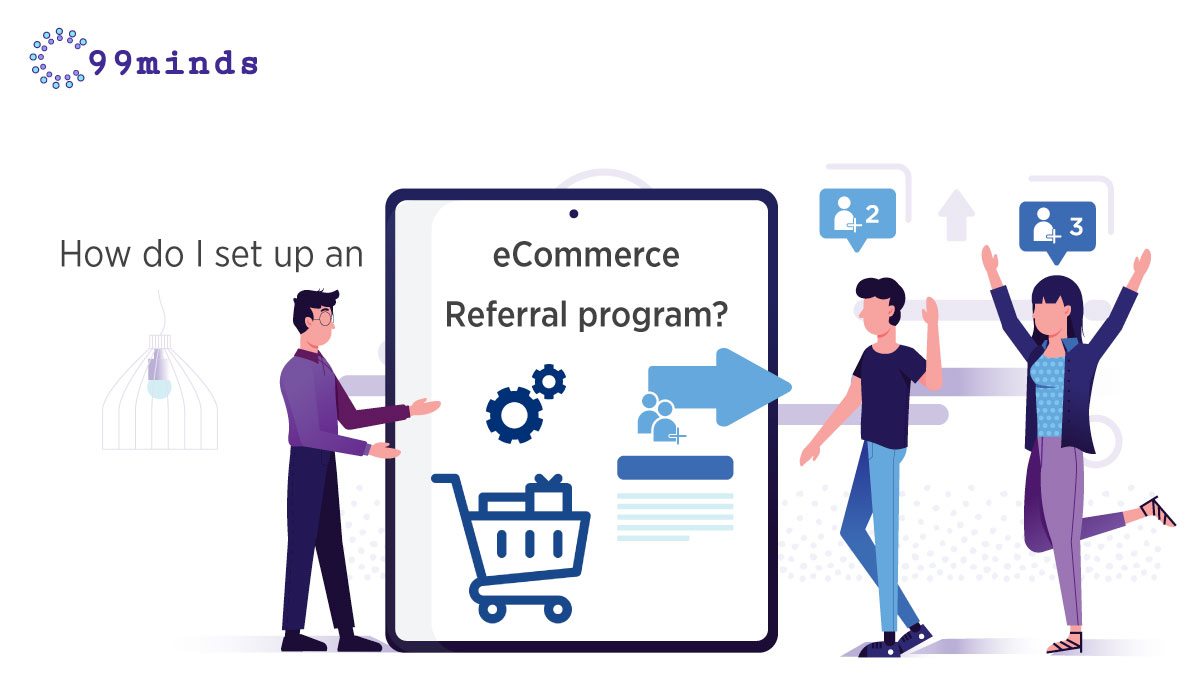
Mrudul

A referral program is an incentive structure for your customers to share about your products and services for rewards. It could be any reward- store credits, cash, free trip, free consultation, additional perks, exclusive access, free products, etc. It is up to the business to decide.
Ecommerce stores have managed to reduce their customer acquisition costs by employing referral programs. Since companies are only paying for performance (aka referrals), there is no loss.
Referrals are extremely powerful because people believe other people like themselves when they suggest something. A Neilsen study says that more than 92% of people trust the recommendations of friends and families. That’s precisely why social proof, positive comments on forums, customer testimonials, and reviews play a huge role in people buying from you.
Let us look at how to set up an eCommerce referral program:
What does your customer get for promoting your products and services? You need to carefully choose this as it has a lot of bearing on your referral program’s results. If you are unsure how to proceed, you can start with low-key incentives. Make it easy for customers to share the referral links.

Discounts- Offering discounts ensure that they visit your eCommerce store immediately. Extend the discount to both the referrer and the referee.
Free gift- Want a great way to make your customers hooked to your line of products? Give them an exclusive gift so that it is worth the effort of referring one’s friends and family.
Experiences- Find an experience that your audiences can relate to and offer. It will also make way for great user-generated content (UGC) to help with marketing.
Points- Offer reward points for each referral that can be redeemed once it reaches a certain number of points. The referrers can redeem the points in gifts, discounts, experiences, etc.
A special landing page explaining your referral program is a must-have. It allows you to share your referral program with your audience in a centralized location. The objective of having a landing page is to show your customers the value of joining your referral programs. After creating the landing page for referrals, work on bringing traffic to it.
The next step is to market your referral programs to your eCommerce customers. Email campaigns have an ROI of 4200%. Overdo the promotions, and you might alienate your customers. Do remember that your customers are bombarded with promotions and offers. It pays to be subtle while effectively championing the cause of your referral programs.
To make your email campaigns effective, segment your audience. Gather as much demographic, psychographic and behavioral data of your customers. Use them to divide your customers based on these shared attributes. It will increase the efficiency of your email campaigns. Based on the rewards you offer, you can choose which segment of customers will be informed about the referral program.
If you don’t bother to track the performance of your referral program, you’ll never know what works and what doesn’t. Keep tracking your data so that you have a fair understanding of the results that you are getting. Find out areas where you can improve. Identify customer segments that don’t bother to interact with your communication. Use this information to tweak your referral programs.
There are tools such as 99minds that helps create effective referral programs. It will simplify the entire process and make getting referrals easy. Such tools have features that help create and manage referral programs. You can monitor the engagement and personalize your communication to get better results.
Common mistakes in referral programs:
While creating a referral program isn’t hard, it does require ample thought and effort to get it right. Let us look at some of the commonly-repeated mistakes.
Examples of effective eCommerce referral programs:
Let us look at a few examples of effective eCommerce referral programs that were successful.
It encourages customers to share by offering a two-way discount where both the referrer and referee stand to benefit.
They have a refer-a-friend incentive. The referrer gets a $10 discount off the first order of $75+ in exchange for 50 points. Every 50 points earned is a $5 discount.
The ride-sharing app built referral into its product as it assigned personalized referral codes as soon as an account was activated. When a new account is created using a referral code, both parties get their next Uber ride free. When the referrer knows that their connection is also getting something in return, they are more likely to refer.
It’s a food delivery service that provides a $25 credit when a friend signs up. It is challenging to gain loyalty for food delivery apps since customers are looking for the best discount, offering such incentives makes them stay.

The note-taking app awarded points to customers who made referrals. These points could be used to get free access to the premium version of the software. Each time the referred friend upgrades, the customer who referred receives additional points. When they attained 100 million users, 13 million of them were from referrals.
Shopify store Zooshoo, a women’s shoe store, asks their email subscribers to refer their friends to get $10 for every order above $40 placed by their friends.
Even though Morning Brew is not an eCommerce store, it is worth mentioning how they could grow their audience to 1.5 million with a simple strategy. Since they send a daily newsletter to their subscribers, they added a section to encourage referrals. Their rewards program had a variety of incentives: stickers, phone wallets, coffee mugs, etc. Their readers could share the newsletter directly from the email itself.
They used to offer an extra 500 MB of free space to the customer and the ones who get referred. The referral program increased its membership by 60% in 2010. Offering product-based incentives will make the customers more invested in your product.
The electric car company has changed the referral program over the years. At one point, they offered customers $1,000 to refer-a-friend. Another referral strategy that was on offer was access to an exclusive Powerwall 2 battery for Tesla owners who referred multiple people. Other referral rewards included invitations to exclusive parties and the opportunity to purchase special edition products.
Conclusion:
Marketers love referral programs because they know it works. It results in vitality and reduces customer acquisition charges, making it an attractive proposition. Building a successful referral program requires leadership buy-in, choosing the right incentives, and the right referral software. It should be simple, easy to implement and make changes and give instant benefits to the referrers.
If you want to add a referral program to your eCommerce website, get in touch with the folks at 99minds. We will be more than happy to help set up your referral program.